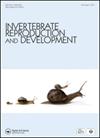Description of the postmarsupial manca stages of Armadillidium ficalbii (Crustacea, Isopoda, Oniscidea)
IF 0.8
4区 生物学
Q4 REPRODUCTIVE BIOLOGY
引用次数: 0
Abstract
ABSTRACT The postmarsupial manca stages of Armadillidium ficalbii Arcangeli, 1911 were studied in detail by morphological analysis. Ovigerous females were reared separately under controlled conditions, allowing us to follow the stages of development from release from the marsupium until the appearance of the first juvenile stage, identified by the full development of the seventh pair of pereopods. Each newborn was followed to record the subsequent moults that identify the three postmarsupial manca stages. Manca stage M I had a mean duration of 10 h, manca stage M II 8–9 days, and manca stage M III 9–10 days. The cephalothorax width was measured to provide a growth measure for each stage. The mean values of the cephalothorax width were: 0.589 mm for M I, 0.718 mm for M II and 1.274 mm for M III. The morphological modifications in the three postmarsupial manca stages were described, the body parts illustrated, and SEM images taken. The distinguishing characteristics among mancas were discussed, and comparisons made with manca stages of other terrestrial isopod species.菲氏Armadillidium ficalbii(甲壳纲、等足目、洋葱总科)成年后阶段的描述
摘要通过形态学分析,详细研究了菲氏Armadillidium ficalbii Arcangeli(1911)的交配后阶段。产卵的雌性在受控条件下单独饲养,使我们能够跟踪从有袋动物释放到第一个幼年阶段的发育阶段,通过第七对游足动物的完全发育来确定。对每个新生儿进行跟踪,记录随后的蜕皮,以确定成年后的三个阶段。曼卡Ⅰ期的平均持续时间为10小时,曼卡Ⅱ期为8-9天,曼卡Ⅲ期为9-10天。测量头胸部宽度以提供每个阶段的生长测量。头胸宽度的平均值为:M I为0.589 mm,M II为0.718 mm,M III为1.274 mm。描述了成年后三个阶段的形态变化,图示了身体部位,并拍摄了SEM图像。讨论了曼卡的区别特征,并与其他陆生等足类的曼卡阶段进行了比较。
本文章由计算机程序翻译,如有差异,请以英文原文为准。
求助全文
约1分钟内获得全文
求助全文
来源期刊
CiteScore
1.90
自引率
0.00%
发文量
21
审稿时长
>12 weeks
期刊介绍:
Invertebrate Reproduction & Development ( IRD) presents original research on the reproductive and developmental biology of the Invertebrata, both embryonic and postembryonic. IRD welcomes papers reporting significant results obtained using new techniques. Encouraged topic areas include: aquaculture, physiology, biochemistry, functional morphology, phylogeny, behavioural and regulatory mechanisms, including genetic, endocrine and molecular studies. Papers containing qualitative descriptions of reproductive cycles and gametogenesis will not be considered. IRD is published in association with the International Society of Invertebrate Reproduction and Development.

 求助内容:
求助内容: 应助结果提醒方式:
应助结果提醒方式:


